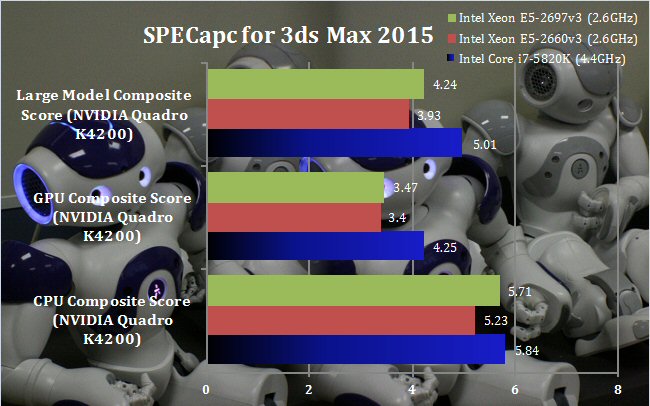Test Software
For this article, we used test workloads that are specifically designed to work with full versions of the popular Autodesk applications 3ds Max and AutoCAD. Rather than being based on the codebase and type of workload used (as with SPECviewperf 12.02), these two tests run actual tasks inside the software itself. So they provide a real-world analysis of how particular configurations will behave with the software in question.
SPECapc for 3ds Max 2015 is performance evaluation software for systems running Autodesk 3ds Max 2015. The benchmark was introduced on August 13, 2014. The benchmark requires that users have a working version of 3ds Max 2015 with Service Pack 1 applied.
SPECapc for 3ds Max 2015 contains 48 tests for comprehensive measurement of modeling, interactive graphics, visual effects, CPU and GPU performance.
Features in the latest SPECapc benchmark are keyed to upgrades in 3ds Max 2015, including new DirectX 11 shaders and vector maps, Nitrous viewport enhancements, and new dynamics and visual effects. The benchmark also improves run-to-run consistency and results reporting.
Benchmark results are derived by taking the total number of seconds to run each test and normalizing it based on a reference machine, in this case a Dell Precision 690 workstation with 2.0-GHz Intel Xeon 5130 processor, 4 x 4GB FB-DIMM DDR2 SDRAM (ECC) memory, NVIDIA Quadro Q600 graphics card, and Western Digital 500GB 7200 rpm hard drive. The normalization process ensures a scoring system where a bigger score is better. Composite scores are reported for CPU, GPU and large-model (city scene) performance.
The benchmark can be run at 4k and HD resolutions, and at different anti-aliasing levels: 0xAA (default), 2x, 4x, and 8x AA, although we performed all tests at the default setting.
Due to the time this benchmark takes to run, we focused our test on comparing the three different systems when sporting he same graphics card. We will return to the test in a future article to show how changes in graphics card affects modelling.
Our results show it's quite clear yet again that the number of CPU cores available is not so significant. But clock speed does provide benefits. The Intel Core i7-5820K running at 4.4GHz wins in every category, and the Xeon E5-2697v3 (with its 3.6GHz Turbo Boost mode) comes second.
Interestingly, though, whilst the extra core clock provides 18 per cent extra performance in the Large Model Composite test, and over 22 per cent in GPU Composite, the CPU composite score for the 14-core Xeon is only a couple of percent behind. Since the SPECapc benchmark mostly focuses on modelling, our test shows that for the GPU and large model-focused work, clock speed is king.
But multiple cores begin to regain the upper hand for CPU-intensive workloads, as 3ds Max can get some benefit from these.
 KitGuru KitGuru.net – Tech News | Hardware News | Hardware Reviews | IOS | Mobile | Gaming | Graphics Cards
KitGuru KitGuru.net – Tech News | Hardware News | Hardware Reviews | IOS | Mobile | Gaming | Graphics Cards



